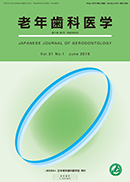Volume 36, Issue 1
Displaying 1-17 of 17 articles from this issue
- |<
- <
- 1
- >
- >|
History of the Society
-
2021 Volume 36 Issue 1 Pages 3-6
Published: June 30, 2021
Released on J-STAGE: July 19, 2021
Download PDF (4802K)
Review Articles
-
2021 Volume 36 Issue 1 Pages 7
Published: June 30, 2021
Released on J-STAGE: July 19, 2021
Download PDF (136K) -
2021 Volume 36 Issue 1 Pages 8-12
Published: June 30, 2021
Released on J-STAGE: July 19, 2021
Download PDF (3514K) -
2021 Volume 36 Issue 1 Pages 13-16
Published: June 30, 2021
Released on J-STAGE: July 19, 2021
Download PDF (1648K) -
2021 Volume 36 Issue 1 Pages 17-20
Published: June 30, 2021
Released on J-STAGE: July 19, 2021
Download PDF (1066K) -
2021 Volume 36 Issue 1 Pages 21-23
Published: June 30, 2021
Released on J-STAGE: July 19, 2021
Download PDF (269K) -
2021 Volume 36 Issue 1 Pages 24
Published: June 30, 2021
Released on J-STAGE: July 19, 2021
Download PDF (86K) -
2021 Volume 36 Issue 1 Pages 25-27
Published: June 30, 2021
Released on J-STAGE: July 19, 2021
Download PDF (515K) -
2021 Volume 36 Issue 1 Pages 28-31
Published: June 30, 2021
Released on J-STAGE: July 19, 2021
Download PDF (765K) -
2021 Volume 36 Issue 1 Pages 32
Published: June 30, 2021
Released on J-STAGE: July 19, 2021
Download PDF (127K) -
2021 Volume 36 Issue 1 Pages 33-35
Published: June 30, 2021
Released on J-STAGE: July 19, 2021
Download PDF (1709K) -
2021 Volume 36 Issue 1 Pages 36-39
Published: June 30, 2021
Released on J-STAGE: July 19, 2021
Download PDF (699K) -
2021 Volume 36 Issue 1 Pages 40-43
Published: June 30, 2021
Released on J-STAGE: July 19, 2021
Download PDF (987K)
Original Article
-
2021 Volume 36 Issue 1 Pages 44-52
Published: June 30, 2021
Released on J-STAGE: July 19, 2021
Download PDF (1919K)
Reports on Survey
-
2021 Volume 36 Issue 1 Pages 53-64
Published: June 30, 2021
Released on J-STAGE: July 19, 2021
Download PDF (1273K) -
2021 Volume 36 Issue 1 Pages 65-71
Published: June 30, 2021
Released on J-STAGE: July 19, 2021
Download PDF (1087K)
Health Activity Report
-
2021 Volume 36 Issue 1 Pages 72-78
Published: June 30, 2021
Released on J-STAGE: July 19, 2021
Download PDF (2964K)
- |<
- <
- 1
- >
- >|
